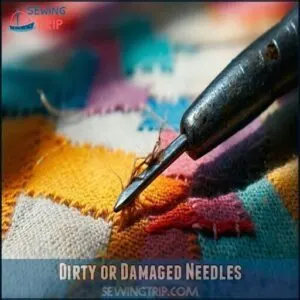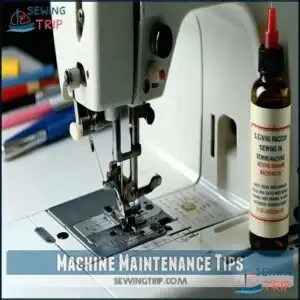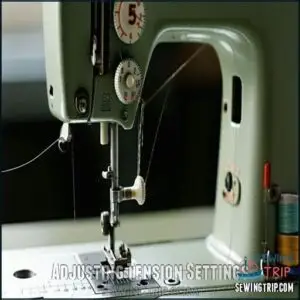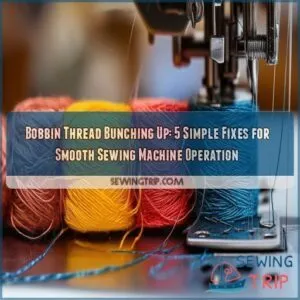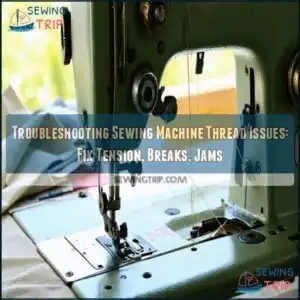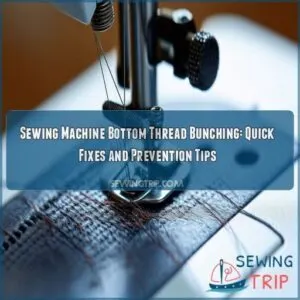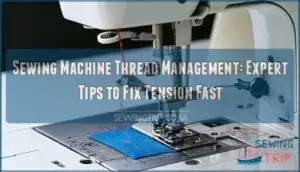This site is supported by our readers. We may earn a commission, at no cost to you, if you purchase through links.
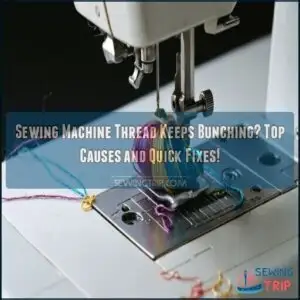
Start by checking the top and bobbin threading—one misstep can throw the whole thing off. Make sure the top thread is snug in the tension discs and the bobbin’s placed correctly.
Adjust the tension settings, but don’t overdo it—aim for balance, like a tug-of-war with evenly matched teams.
Clean out any lint or dust, especially in the bobbin case. Still stuck? Double-check the needle; a bent or dull one can wreak havoc.
Quick fixes now save bigger headaches later, so don’t skip maintenance!
Table Of Contents
Key Takeaways
- Check your threading—one small misstep, like skipping a tension disc or misplacing the bobbin, can throw everything off.
- Clean out lint regularly, especially in the bobbin area, to prevent thread bunching and other sewing machine issues.
- Adjust thread tension carefully—start with the top thread, test on scrap fabric, and tweak the bobbin if needed for balance.
- Replace bent or dull needles and use high-quality thread to avoid stitching problems and messy results.
Thread Bunching Causes
Thread bunching happens when your sewing machine’s thread tensions aren’t balanced, and it can be frustrating to figure out why.
From incorrect bobbin threading to loose tension settings, small mistakes often lead to big knots, and understanding these issues is key to resolving thread bunching.
Tension Imbalance Issues
Thread tension imbalance can make sewing feel like herding cats.
Thread tension woes can turn sewing into a chaotic adventure—mastering balance keeps your stitches purring like a well-tuned machine.
To fix this, check:
- Thread size matches the fabric weight and stitch length.
- Verify proper thread tension adjustment for top and bottom threads.
- Monitor bobbin tension with a gentle tug for smooth resistance.
- Confirm the presser foot is down while sewing.
Addressing these tension issues keeps stitching smooth!
Bobbin Threading Errors
In the context of bobbin threading errors, even small mistakes can cause big headaches.
A misaligned bobbin or ignored tension spring leads to nasty thread bunching. Avoid bobbin problems by using the correct bobbin type, ensuring proper bobbin placement, and checking bobbin winding.
Keep the case maintained to reduce sewing machine problems caused by thread tension issues. Regular cleaning helps prevent dust and lint accumulation.
| Issue | Cause | Fix |
|---|---|---|
| Thread bunching | Misaligned bobbin | Realign the bobbin in its case properly. |
| Loose stitches | Tension spring issue | Engage the tension spring securely. |
| Erratic stitches | Poor bobbin winding | Rewind the bobbin evenly and tightly. |
Incorrect Needle Thread Tension
A sneaky culprit behind needle thread tension issues is improper setup.
Check your sewing machine’s thread path to confirm proper threading—don’t skip those tension discs! Adjust the tension dial slowly to find the sweet spot.
Also, lower the presser foot before sewing, and use the correct needle size and thread quality.
Nail these basics to avoid pesky thread bunching causes!
Needle Thread Problems
If your thread keeps bunching, the needle thread might be the culprit. Proper threading, a lowered presser foot, and a clean, undamaged needle can quickly solve the problem.
Thread bunching driving you crazy? Check threading, lower the presser foot, and inspect the needle for a smooth sewing experience!
Incorrect Needle Threading
When sewing machine thread bunches, check your threading steps.
Skipping the tension disc or missing the thread guide is like forgetting socks on a cold day—nothing works right.
Verify the thread is properly in the uptake lever and spool placement isn’t off.
Sewing machine needle threading must follow the manual exactly to avoid missteps and needle issues, ensuring that every step is carefully considered to prevent problems, with complete concepts of threading in mind.
Incorrect Presser Foot Position
Leaving the presser foot up might feel harmless, but it disrupts thread tension, leading to thread bunching or thread nests.
For smooth sewing, lower the presser foot before starting. This improves fabric feed and reduces skipped stitches or uneven stitching.
If the presser foot height isn’t right, adjust it. Proper foot pressure matters in sewing machine troubleshooting, and ensuring it is correct is crucial for smooth sewing.
Dirty or Damaged Needles
If the thread nests won’t stop, inspect your sewing machine needle first.
A dirty or damaged needle disrupts stitch quality, leading to bunching nightmares.
Regular needle inspection confirms it’s not bent or dull.
Needle replacement is quick—match needle types to your fabric for smoother results.
Ignoring needle care? That’s a fast track to frustrating sewing machine problems.
A related issue can arise with the automatic needle threader, so verify it’s functioning correctly to avoid sewing machine problems.
Machine Maintenance Tips
If your sewing machine is acting up, it might be time for some maintenance.
Regular cleaning, proper oiling, and checking for worn parts can keep your machine running smoothly and prevent thread bunching.
Regular Cleaning Schedule
When your sewing machine’s thread tangles or bunches, lint is often the culprit.
Stick to a regular sewing machine cleaning routine to avoid chaos. Use cleaning tools like brushes to remove lint under the throat plate and around the bobbin.
Schedule adherence matters—don’t skip it. Regular oiling of parts guarantees smooth machine operation.
A small effort in sewing machine maintenance prevents big future headaches, ensuring smooth machine operation is key to a hassle-free sewing experience.
Proper Oiling Techniques
Precision matters in sewing machine oiling. Here’s how to avoid thread bunching:
- Use the right oil type—skip cooking oils!
- Stick to the suggested oiling frequency; over-oiling leads to residue buildup.
- Target key application points like the hook race and needle bar.
Clean spilled oil during sewing machine cleaning. Using specialized machine lubricants can prevent damage.
Proper oiling keeps your machine running smooth and thread trouble-free.
Checking for Worn Parts
If your thread bunching persists, it might be time to inspect feed dogs, check for a bent needle plate, or examine the bobbin case for wear.
Look at gears and belts for any cracks or slack, and test motor functionality too.
You might even consider feed dog replacement if they’re damaged. Sometimes, sewing machine repair involves spotting worn parts causing sewing machine thread tangling before they worsen!
Troubleshooting Steps
When your sewing machine thread starts bunching, a few quick troubleshooting steps can save you frustration.
Let’s re-thread the machine, tweak the tension, and clean out any pesky lint hiding in the bobbin area to get things running smoothly again.
Re-threading The Machine
Got thread tangling again? It’s time to rethread! Follow these quick steps for perfect stitching:
- Completely unthread the sewing machine.
- Use the Threading Guide to feed thread through the proper Thread Path.
- Gently floss it through the Tension Discs.
- Verify the Bobbin Seating is snug.
- Check the Uptake Lever for smooth threading!
Adjusting Tension Settings
If re-threading didn’t fix the thread bunching, check your sewing machine tension settings.
Use the tension dial guide to adjust thread tension for balanced stitch formation. Match your fabric thread pairing to avoid uneven stitches.
Don’t overlook the bobbin case adjustment—refer to the tension troubleshooting chart for guidance. Tweaking these settings keeps thread snarls at bay!
Checking for Lint Buildup
If adjusting tension doesn’t stop the thread bunching, it’s time to check for lint buildup.
Dust loves to hide under the throat plate, around the bobbin case, and in the feed dogs.
Regular lint removal with a brush or compressed air keeps the sewing machine running smoothly.
Include throat plate dusting and bobbin case cleaning in your sewing machine maintenance routine for stress-free stitching.
For peak performance, follow a sewing machine maintenance checklist to keep your machine in top condition.
Preventing Future Issues
You can keep thread bunching at bay by using quality thread, adjusting tension correctly, and inspecting your machine regularly.
Taking these small steps will save you frustration and keep your sewing projects running smoothly.
You will be rewarded with a better sewing experience if you follow these simple steps.
Using High-Quality Thread
High-quality thread makes all the difference in sewing success.
It’s stronger, smoother, and better at reducing lint, keeping your machine clean and improving stitch quality.
Cheap threads create fuzz that messes with bobbin tension and can lead to frustrating thread bunching.
Always pick durable threads that match your fabric’s needs—your projects and your patience will thank you.
For a great selection, consider exploring options for superior sewing threads, which can provide high-quality results and help you achieve sewing success.
Properly Adjusting Tension
Proper tension keeps your stitches smooth and saves you headaches.
Follow these steps:
- Adjust the tension dial guide slowly while testing on fabric scraps.
- Match your fabric-thread pairing and inspect the stitch appearance.
- Troubleshoot in order—needle tension first, then bobbin tension.
A few tweaks can prevent thread bunching and keep your sewing machine tension adjustment hassle-free!
Regularly Inspecting The Machine
Inspecting your machine regularly keeps thread bunching at bay.
Start with a quick checkup for part wear or misalignment affecting tension or the bobbin.
Use this guide:
| Task | Tools Needed | Frequency | Why It Matters |
|---|---|---|---|
| Internal Cleaning | Brush, Air Blower | Monthly | Reduces lint buildup |
| Scheduled Checkups | Machine Manual | Every 6 Months | Guarantees mechanical alignment |
| Part Wear Check | Visual Inspection | Every 3 Months | Prevents serious repairs later |
| Tension Adjustment | Screwdriver | As Issues Arise | Stops thread bunching disasters |
Scheduled inspections save headaches—your machine will thank you, as it helps prevent serious issues and ensures proper maintenance, leading to a longer machine lifespan.
Frequently Asked Questions (FAQs)
How do I stop my sewing machine thread from bunching up?
Your sewing machine’s throwing a thread tantrum?
First, re-thread the machine carefully.
Check bobbin placement and tension. Clean out lint, lower the presser foot, and use quality thread.
Adjust stitch tension to balance everything.
Why does my sewing machine keep jamming underneath?
Your sewing machine jams underneath because of tension issues, improper threading, or lint buildup.
Double-check the bobbin threading, clean out debris, and adjust tension settings.
A poorly seated bobbin or dull needle might also cause trouble, consider these as potential issues to address for a smoother sewing experience.
How to fix sewing machine birdnesting?
Start by rethreading your machine, top and bobbin, following the manual.
Check thread tension, cleaning any lint in the bobbin area.
Lower your presser foot before sewing, and use high-quality thread and sharp needles.
Why is one thread bunching up under my fabric when sewing?
It’s like a tug-of-war gone wrong—thread bunching happens when your top thread tension is too loose or bobbin tension’s off.
Re-thread carefully, lower the presser foot, and check tension settings to fix it!
How does fabric type affect thread bunching?
Fabric type matters because heavy or stretchy fabrics often need adjusted tension or specific needles.
Thin fabrics bunch if tension is too tight.
Matching fabric, thread, and needle type reduces issues, making stitching smoother.
Why does thread bunch during reverse stitching?
Ever feel like reverse stitching is the wild card?
It often happens because tension shifts slightly or threads aren’t firmly held.
Keep tension steady, re-thread carefully, and hold thread tails when starting reverse stitching.
Can sewing speed impact thread tension balance?
Yes, sewing too fast can mess with thread tension.
Rapid speeds might pull thread inconsistently, causing imbalanced stitches.
Slow it down, especially during tricky sections, to help your machine keep everything smooth and balanced.
Does bobbin material influence thread behavior?
Picture the bobbin as the heart of your sewing machine—it pumps life into your stitches.
Plastic bobbins can expand under heat, while metal ones stay sturdy.
Stick to your machine’s recommended type for smooth sewing.
How to fix bunching with delicate fabrics?
Start by lowering thread tension slightly and using a sharp needle designed for delicate fabrics.
Thread the machine carefully, ensuring tension discs engage properly.
Hold thread tails when starting, and slow down for precision stitching.
Conclusion
Struggling when your sewing machine thread keeps bunching? Don’t worry—it’s usually easy to fix!
Double-check your threading and tension settings, then clean out any lint that’s causing chaos. A bent needle or mismatched thread could also be the culprit.
Regular maintenance—like cleaning and oiling—is key to avoiding future headaches.
Keep your machine in top shape, and it’ll reward you with smooth stitching. Take a deep breath, troubleshoot patiently, and get back to creating!




